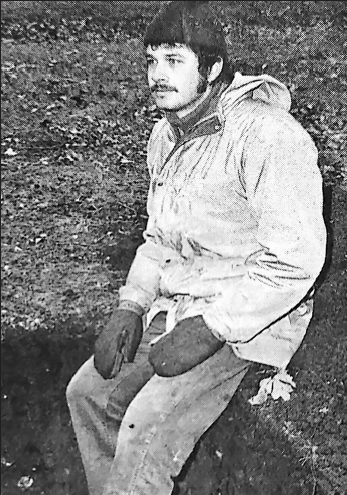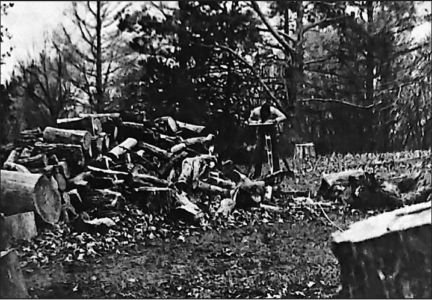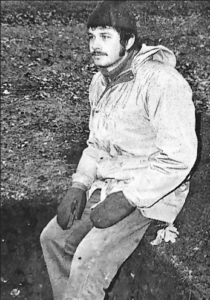STUDYING THE PAST-Tim Ready, above, lines up the sights on his surveying instrument to measure elevation at the crest of Fort Hill. Measurements will pinpoint where Fort Hill stood.
Residue found at Lake Hanska Park seems unglamorous to the layman but it has turned on two archeologists who are completing a preliminary survey there.
The exciting debris includes turtle, fish and bison bone fragments, pottery fragments, rock tools such as scrapers, and stains in the ground which show where fire pits or structures were located in pre-historic camps.
JOE HUDAK, one of the scientists, called the Lake Hanska site very important and said it could yield information on a Woodland tribe which lived there about 250 B.C. and about which very little is known.
Hudak has seven years archeological experience including four years of undergraduate work plus graduate work concentrating on Southern Minnesota archeological sites.
Any amateur digging in the park would destroy the subtle clues out of which the archeologists construct a picture of a 2,000-year-old culture,Hudak emphasized. The residue must be found as it was left by the original tribesmen to tell the story of how they lived.

Joe Hudak, at right, sits in an excavation which shows three layers of past civilizations. The rocks at the bottom of the wall near Hudak’s feet are the cultural debris of an early Woodland tribe. (Photos by Sally Du Four)
Amateur digging on archeological sites also is illegal, under state law.
WHEN THE archeologists dig they go down inch by careful inch, mapping what they find at each level and marking out the location of the hole so later investigators can use the information.
Hudak and Tim Ready, both from the Minnesota Science Museum, have found evidence of settlements from three different time periods along Lake Hanska.
Historic man (recorded history) lived at the Ft. Hill site in the park. Two different pre-historic tribes lived in the park, an agricultural tribe sometime between 1000 A.D. to the time of European contact, and a hunting tribe sometime between 500 B.C. and 1000 A.D.
The preliminary survey was necessary to find areas of former human occupation so that development of trails and picnic shelters at the county park next spring could avoid these areas. The survey was financed by $7,000 in county funds.
THE TWO MEN first made soil borings at regular intervals all over the park, which through chemical analysis showed areas of high human occupation.
Then small test excavations were made at sites of high human occupation to find out the kind of occupation and the period.
One hole, for example, yielded a first layer from the early 1900’s when the dance pavilllion was located along the lake, with beer caps and modern nails the cultural residue.
The next layer down in this hole was sterile earth, then a layer from sometime between 1000A.D. to the time of European contact, then sterile earth, then a layer from between 500 B.C. to 1000A.D.
THE LAST thing to be done will be surface surveys to show, for example, the exact outline of Fort Hill. This will be completed next week.
The preliminary survey can only estimate the extent and importance of the sites. Actual full-scale digging will have to wait, possibly several years, until money is available from the state historical society or someone else.
If complete excavations are made sometime in the future any findings would eventually be kept at the county historical museum or even possibly in an interpretive display at the park.
New Ulm Daily Journal
Nov. 14, 1974
- STUDYING THE PAST-Tim Ready, above, lines up the sights on his surveying instrument to measure elevation at the crest of Fort Hill. Measurements will pinpoint where Fort Hill stood.
- Joe Hudak, at right, sits in an excavation which shows three layers of past civilizations. The rocks at the bottom of the wall near Hudak’s feet are the cultural debris of an early Woodland tribe. (Photos by Sally Du Four)
This post was originally published on here









